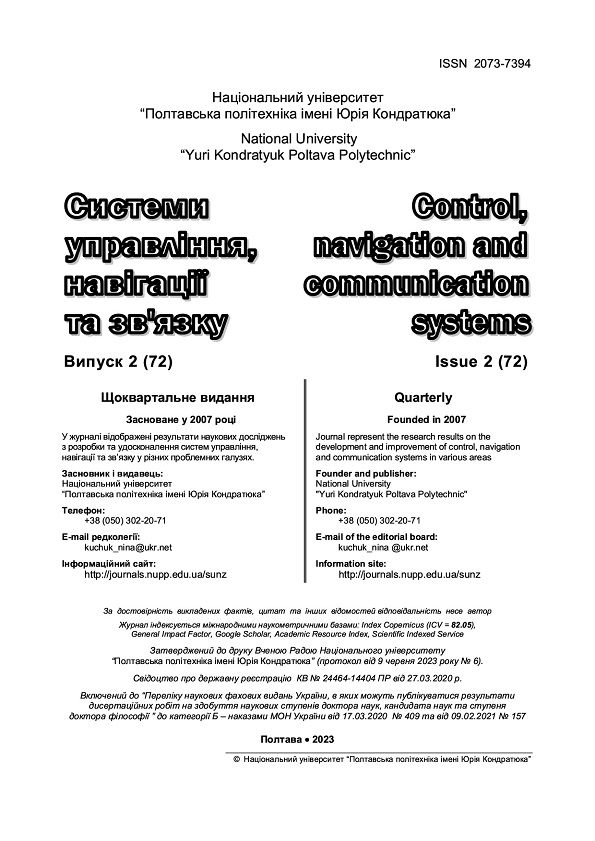ДОСЛІДЖЕННЯ ІМУННИХ ОПЕРАТОРІВ В МОДЕЛІ ШТУЧНОЇ ІМУННОЇ МЕРЕЖІ
DOI:
https://doi.org/10.26906/SUNZ.2023.2.158Ключові слова:
штучні імунні системи, антитіло, антиген, афінность, клонування, супресії, повна специфічність, умовна специфічність, супресія імунної мережіАнотація
Актуальність. Значною актуальністю в області інформаційних технологій користуються моделі та методи, які дозволяють проводити інтелектуальну обробку та систематизацію даних. Серед таких моделей можна виділити моделі, які працюють на основі біологічних принципів організації обчислень, такі як штучні нейронні мережі, генетичні алгоритми та штучні імунні системи. На сьогоднішній день існує декілька видів моделей штучних імунних систем, які використовують специфічні імунні оператори, що впливають на швидкість роботи моделі та якість вирішення практичних задач. Метою даної роботи є дослідження впливу організації роботи найбільш поширених імунних операторів на швидкість роботи імунних алгоритмів та точність прийняття рішення щодо класифікації об’єктів з контрольованим навчанням. Об’єктом дослідження є імунні оператори клонування, мутації та супресії, а також оцінка швидкості процесу формування імунної відповіді мережі антитіл на популяцію антигенів. Предметом дослідження є модель штучно імунної мережі та алгоритм aiNET, імунні оператори та їх вплив н процес формування імунної відповіді для класифікації об’єктів з контрольованим навчанням. Результати. У даній роботі запропоновано оптимальне налаштування імунних операторів для забезпечення високої швидкості формування імунної відповіді алгоритмом aiNET під час вирішення задачі класифікації. Окрім того запропоновано використання цільових імунних об’єктів для пришвидшення класифікації антитіл, що не набули стану специфічності до антигенів навчальної вибірки. Висновок. Модифікований метод aiNET класифікації з контрольованим навчанням планується використовувати у подальшому для керування поведінкою персонажів в ігрових додатках типу action.Завантаження
Посилання
R.O. Duda, P.E. Hart, D.G. (2010), Stork, Pattern classification. Wiley & Sons.
D. Dasgupta, L.F. Nino. (2009), Immunological computation, Theory, and applications. Taylor & Francis Group.
D. Dasgupta, S. Yu, L.F. Nino. (2011), Recent Advanced in Artificial Immune Systems: Models and Applications. Applied Soft Computing, Elsevier P. 1574-1587.
M. Read, P.S. Andrews, J.Timmis. (2012), An Introduction to Artificial Immune Systems. In Handbook of Natural Computing, Shringer, Berlin, Germany P. 1575–1597.
K.B. Bahekar. (2020), Classification techniques based on Artificial immune system algorithms for Heart disease using Principal Component Analysis. International Journal of Scientific Research in Science, Engineering, and Technology, IJSRSET, Vol. 7, Iss. 5, P. 150-160.
S. Shekhar, D.K. Sharma, D.K. Agarwal, Y. Pathak. (2022), Artificial Immune Systems-Based Classification Model for Code-Mixed Social Media Data. IRBM, Vol. 43, Iss. 2, P. 120-129.
R.M. Mikherskii, M.R. Mikherskii. (2021), Analysis of the Use of Artificial Immune Systems. In: IOP Conference Series: Materials Science and Engineering, P 1-6.
H. Park, J.E. Choi, D. Kim, S.J. Hong. (2021), Artificial immune system for fault detection and classification of semiconductor equipment. Electronics, Vol. 10, No. 8, 944, P.1-14.
S.S.F. Souza, F.P.A. Lima, F.R. Chavarette. (2020), A New Artificial Immune System Based on Continuous Learning for Pattern Recognition. Revista de Informatica Teorica e Aplicada, RITA. Vol. 27, No. 04, P. 34-44.
A.T. Haouari, L. Souici-Meslati, F. Atil, D. Meslati. (2020), Empirical comparison and evaluation of artificial immune systems in inter-release software fault prediction. Applied Soft Computing Journal, 96, P. 1–18
V. Cutello, G. Nicosia. (2022), Multiple learning using immune algorithms. In: Proceedings of 4th International Conference on Recent Advances in Soft Computing, RASC, P. 102–107.
M. Korablyov, O. Fomichov, N. Axak. (2021), Classification of objects based on a tree-shaped artificial immune network model. Advances in Intelligent Systems and Computing V, Springer, P. 160-172.
C. Lan, H. Zhang, X. Sun, Z. Ren. (2020), An intelligent diagnostic method based on optimizing B-cell pool clonal selection classification algorithm. Turkish Journal of Electrical Engineering and Computer Sciences, 28 P. 3270–3284.




